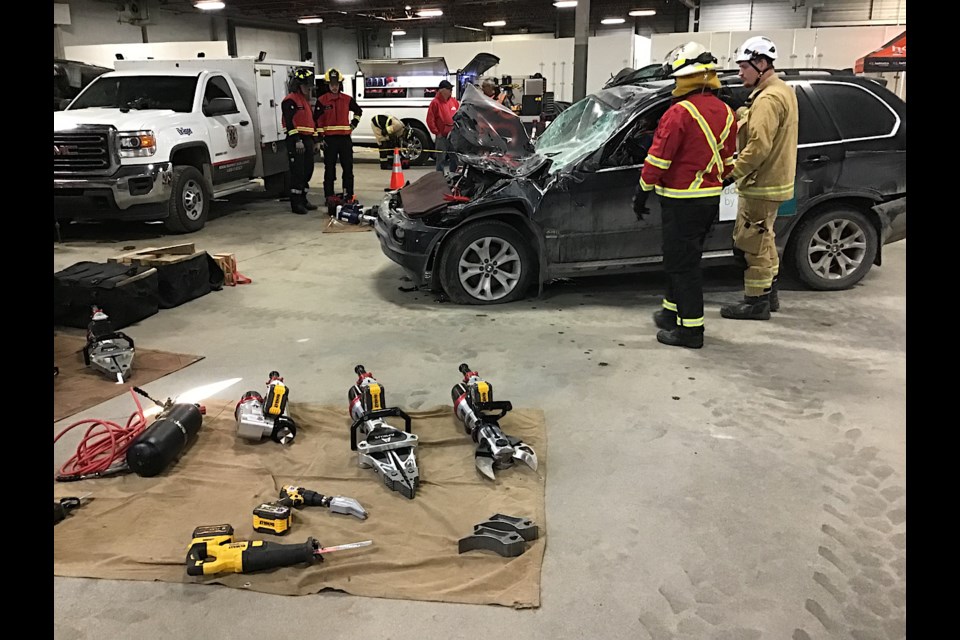REGINA - This weekend, nine fire departments are sending their personnel to Regina for mass training events by the Saskatchewan Public Safety Agency for the Transportation Rescue Extrication Program.
This program, better known as TREX, provides auto extrication training and equipment aimed at emergency personnel who respond to the scene of accidents.
The SPSA is now accepting applications from fire departments for this program. TREX is being supported by a one time funding of $5.6 million from SGI and is administered by the SPSA.
It’s described as a first of its kind program developed along with the Saskatchewan Volunteer Fire Fighters Association, the Saskatchewan Association of Fire Chiefs, and the Provincial Training Standards Committee.
There are about 45 firefighters coming in this weekend from nine departments to Regina for training under the program. The plan for Friday was for them to do classroom training, then starting on Saturday they would do training in six designated pits where the participants would learn about the different types of collisions they find on the roads.
There is also another stream of training where the vendor will go out to train participants in their communities.
SPSA and SGI hosted the launch event for TREX at the REAL District on Friday. Those in attendance included Corrections Policing and Public Safety Minister Christine Tell; Saskatchewan Public Safety Agency President and Fire Commissioner Marlo Prichard and SGI Auto Fund COO JP Cullen.
At the event, a live demonstration took place showing how the auto-extrication equipment work on salvage vehicles. The vehicle that crews worked on was a newer model BMW donated by SGI.
This illustrated the challenges of extricating people from one of the sturdier newer-model vehicles that are equipped with their own safety features.
Zach Miller, service technician at Amkus, described some of the extrication equipment being used.
“The materials in cars is a lot harder, and a lot more durable, so we’ve had to come up with — not so much more durable, but more powerized tools,” said Miller, with “more power to deal with these modern materials.”
The equipment used in the demonstration included an Amkus IS320 spreader, a 32 inch spreader created for 40,000 pound spread capacity.
Also, because of new guidelines, vehicles windows are made in a way that they cannot simply be busted out; they must be cut with glass cutters, so updated tools are required for that as well.
Miller said tools today have had to adapt to deal with heavier and more durable steel used, and car designs including airbags. “It’s tougher to cut, it’s tougher to spead and tougher to move, and so these tools have to update and adapt to that,” he said.
It is crucial, he said, because the faster they can get somebody out of the car and into the hands of medical professionals, the higher the likelihood they are going to survive the accident.
“We see this program is filling a need,” Wayne Rodger, Fire Marshal with SPSA. He said volunteer firefighters from throughout Saskatchewan are seeing the potential for the additional training. It is valuable training for smaller, rural departments as well as bigger fire departments looking for augmentation of their equipment.
Rodger pointed to the importance of being able to have firefighters have the training on newer model vehicles, so that when they are called to the scene they have the experience and are better able to react to save a life.
“This is the piece where technology has taken over. A lot of vehicle analysis is done now in the high-end racing cars. That’s where it starts, in the Formula One and NASCAR. They do a lot of research and engineering, too, and that trickles down to the passenger vehicle that’s on the highway today. So the design and build of a vehicle constructed in 2023 is really different than what we saw 10, 15, 20 years ago because of that technical logical advancement and engineering.”
Rodger was fascinated by the evolution of the tools used, saying the tools being used today to extricate people “are miles ahead of what I was using 30 years ago.” Rodger said that in the old days, it would take two people to operate a spreader. Nowadays it just takes one person.
“That’s what I’m seeing is the advent of the technological advances. It’s all battery operated now, whereas in my past it was all hydraulic, so there was big loud compressors, running in order to compress the hydraulics. So we would’ve all been wearing earplugs because of the noise of the hyperbolic compressors that were going on. That’s what I’m seeing is a big change from from what I experienced."



